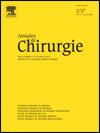Les goitres plongeants. À propos de 212 cas - 01/01/00
M. Makeieff, F. Marlier, M. Khudjadze, R. Garrel, L. Crampette, B. Guerrier
Voir les affiliationsRésumé |
But de l'étude : Cette étude rétrospective avait pour but de rapporter les résultats du traitement chirurgical dans une série de 210 patients opérés pour un goitre cervicothoracique.
Patients et méthode : De 1982 à 1996, 210 patients porteurs d'un goitre cervicothoracique, dont 80 % de femmes, ont été opérés par voie cervicale, sauf deux par sternotomie. Deux patients qui avaient des contre-indications opératoires n'ont pas été opérés. Vingt-cinq patients ont été opérés pour un goitre récidivé plongeant. L'intervention a consisté en une thyroïdectomie totale dans 27 % des cas, une thyroïdectomie subtotale dans 33 % des cast et une lobectomie dans 40 % des cas. Dans 160 cas l'extraction du prolongement rétrosternal a été facile. Dans 48 cas, l'exérèse du goitre plongeant a été facilitée par la découverte du nerf récurrent à son point d'entrée dans le larynx et la dissection vers le bas des attaches trachéales du lobe. La libération complète de la portion cervicale a permis l'ascension de la partie thoracique même volumineuse.
Résultats : Trois carcinomes papillaires ont été découverts. Une paralysie récurrentielle transitoire est survenue chez 7,2 % des patients et une hypoparathyroïdie transitoire chez 13,4 % des patients. Une paralysie récurrentielle définitive a été observée dans 1,2 % des cas, une hypoparathyroïdie persistante dans 2,1 % des cas. Parmi les 25 patients traités pour une récidive de goitre, trois ont eu une parésie récurrentielle transitoire, un une paralysie récurrentielle définitive, quatre (20 %) une hypocalcémie transitoire et un (4 %) une hypocalcémie persistante.
Conclusion : Le scanner cervico-médiastinal et l'IRM permettent d'évaluer les prolongements thoraciques du goitre. L'exérèse thyroïdienne a été réalisée 208 fois sur 210 par voie cervicale. La dissection complète de la partie cervicale du goitre facilite l'ascension du prolongement thoracique.
Mots clés : goitre cervico-thoracique / thyroïdectomie / paralyse récurrentielle / hypoparathyroïdie.
Abstract |
Substernal goiters. Report of 212 cases.
Aim of the study: The aim of this retrospective study was to report the results of the surgical treatment in a series of 210 patients operated on for substernal goiters.
Patients and method: From 1982 to 1996, 210 patients with substernal goiters, including 80 % of women, were operated on via a cervical approach in 208 cases, via a sternotomy in two cases. Two patients with operative contra-indications were not operated on. Twenty-five were operated on for a substernal recurrence on a goiter. In 160 cases, extraction of the substernal portion was easy. In 48 cases, removal of the substernal portion was facilitated by the discovery of the recurrent nerve at its entering into the larynx and downward dissection of the tracheal attachments of the lobe. The complete dissection of the cervical portion made easier the ascension of the substernal portion even in very large substernal components.
Results: Three papillary carcinomas were diagnosed. A transient laryngeal nerve palsy occurred in7,2% of the patients and a transient hypoparathyroidism in 13,4%, A definitive laryngeal nerve palsy occurred in 1,2% of the patients, and a persistant hypoparathyroidism in 2,1%. Of the 25 patients who underwent surgery for recurrence of a goiter, three (12%) developped a transient laryngeal nerve palsy, one (4%) a permament nerve palsy, four (20%) a transient hypoparathyroidism and one (4%) a persistent hypocalcemia.
Conclusion: CT scan and MRI are the best explorations to evaluate intrathoracic extension of substernal goiters. Thyroidectomy was performed via a cervical incision in 208 patients and via a sternotomy in two patients only. The complete dissectionof the cervical portion with discovery of the recurrent nerve at its entering into the larynx, facilitates the ascension of the substernal portion even in very large substernal goiters.
Mots clés : substernal goiters / thyroidectomy / laryngeal nerve palsy / hypoparathyroidism.
Plan
Vol 125 - N° 1
P. 18-25 - janvier 2000 Retour au numéroBienvenue sur EM-consulte, la référence des professionnels de santé.

